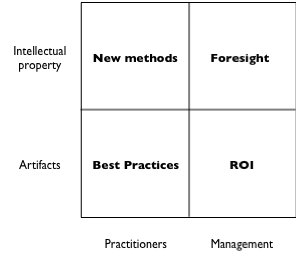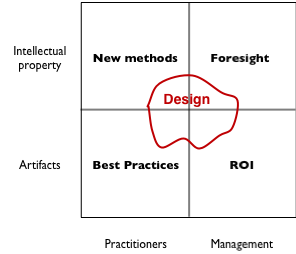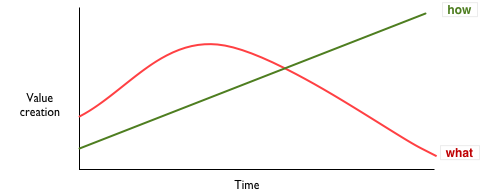March 03, 2005
Design and Strategy: Nobody Knows Anything
Yesterday afternoon I attended the Institute of Design's Strategy Workshop. It was their first attempt at trying to bring their design+strategy message to people outside of Chicago. They had expected about 30 people to register. They sold out at 100, and who knows how many more would have come.
The top draw was probably the panelists--Rob Forbes from Design Within Reach, Bill Hill from MetaDesign, Clement Mok, and Peter Coughlan from IDEO. These are some pretty heavy hitters, and $100 bucks isn't a lot to get some wisdom from them.
I didn't take any notes until Clement spoke, which was too bad, because before him, Rob and Bill spoke. Rob mostly talked about how he considers the operational development of his retail business a case study in design -- fair enough, but not all that meaningful to me. Bill, well, I can't remember what he talked about. I just remember thinking, "Wow. Meta is a dinosaur. They're still coasting on laurels earned in the 80s. What have they done for me recently?" I mean, they're still an excellent graphic design shop, but it's not clear that they are much more than that. They're definitely *not* advancing the dialogue in any meaningful way.
 Clement talked about his experience as president of AIGA and, more recently, his return to Sapient in trying to help them put together a(nother) design practice. Clement, being Clement, thinks in models, and presented two.
Clement talked about his experience as president of AIGA and, more recently, his return to Sapient in trying to help them put together a(nother) design practice. Clement, being Clement, thinks in models, and presented two.
The first was a 2x2 of what design can impact and what folks are interested in...

So, when it comes to artifacts, practitioners are about best practices, and management is about ROI. And when it comes to intellectual property, and other intangible value, practitioners are developing new methods, while managers are seeking foresight.
And the thing is, the process of design is kind of this shapeless mass that touches all of these things...

And Clement feels that the messiness of design is frustrating for folks, and there is an opportunity for bringing clarity to the process.
Clement's second model was even more obtuse...

If I understand it correctly, Clement is simply saying that design adds greater value in the long term by being applied to the HOW of business (practices and process), whereas being applied to the WHAT of business (products) ends up having limited value as those products become commoditized.
I don't know if I share Clement's perspective, but there it is.
 Peter Coughlan discussed his work heading up the transformation practice at IDEO, where, basically, companies come to learn how to be innovative, the IDEO way. It's all about designing business. They lead them through rapid processes, breaking down organizational silos, towards developing products, and then ask them -- okay, what will it take for you guys to get there?
Peter Coughlan discussed his work heading up the transformation practice at IDEO, where, basically, companies come to learn how to be innovative, the IDEO way. It's all about designing business. They lead them through rapid processes, breaking down organizational silos, towards developing products, and then ask them -- okay, what will it take for you guys to get there?
Peter talked a lot about co-creation with the client... How the model has shifted away from designers being given requirements, going away for three months, and returning with The Solution, and toward having clients and designers working together to solve problems. (This was gratifying to hear, if only because this is what we've been doing at Adaptive Path for 4 years...)
Peter identified three stages in working with companies to behave innovatively:
1st Stage: Proof of process
It takes companies a while to "trust the process," particularly because IDEO's process seems so simple.
2nd Stage: Checking what worked, what didn't
Throughout the process, you take good notes, figure out where the shortcomings were, and correct from there.
3rd Stage: Figure out how to replicate
Once you're fairly confident you've figured out how to be innovative within this org, you replicate it throughout the company.
The challenges Peter outlined in getting this to work included:
- Fear of open-ended process
Clients want to KNOW what the results will be. Which, of course, goes against a truly exploratory process. Or they're afraid that the process will get them nothing.
- Coming in without answers, just a process
Typically this kind of organizational change is practiced by management consultants, who come in with answers. IDEO just comes in with process. Clients who are expecting answers right away get antsy.
- Cultural fit with clients -- creating a space for success
Designers at IDEO simply behave differently then the folks at their clients' offices, and it can take a while for everyone to come together.
Peter's group is definitely in the vanguard of what is happening in design practice, and, in contrast to Meta, IDEO is definitely maintaining, if not growing, its position in the dialogue.
What I Took Away From This All
Much like William Goldman said about Hollywood, nobody knows anything. During the presentations, and then in the lengthy discussion within the audience that occurred afterward, it was surprising how little felt resolved.
The discussion, fundamentally, was not about design. At least, not "design" as it is commonly considered. The problem with getting a bunch of designers in a room is that their first impulse is to design their way out of a situation. However, not every problem warrants design. Design is a powerful approach, a powerful tool, but it's not the only one. The context of the discussion very quickly became bigger than "design," but that was never really recognized. I would have loved to see this discussion happen where no one in the room is allowed to use the word "design."
There's a super strong desire among designers to be able to talk to executives. Many are chasing after the upper reaches of the org chart. In my experience, senior executives are some of the last people you want to talk to directly -- instead of being the foresightful vision-holders we expect them to be, they are often unable to get past the minutiae of "where should the search box go?"
There's a burning need in the Bay Area to talk about these issues at a sophisticated level.
